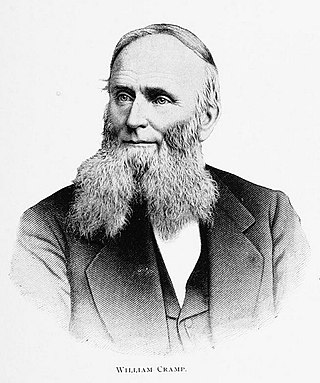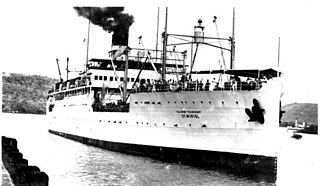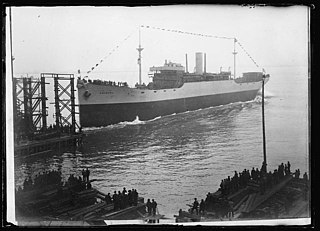
A submarine sandwich, commonly known as a sub, hoagie, hero, Italian, grinder, wedge, or a spuckie is a type of American cold or hot sandwich made from a cylindrical bread roll split lengthwise and filled with meats, cheeses, vegetables, and condiments.

Chester is a city in Delaware County, Pennsylvania, United States. It is located in the Philadelphia metropolitan area on the western bank of the Delaware River between Philadelphia and Wilmington, Delaware. The population of Chester was 32,605 at the 2020 census.

William Cramp & Sons Shipbuilding Company was an American shipbuilding company based in Philadelphia, Pennsylvania, founded in 1830 by William Cramp. During its heyday in late 19th century, it was the preeminent American iron shipbuilder.

The Philadelphia Naval Shipyard was the first United States Navy shipyard and was historically important for nearly two centuries.

Tinicum Township, also known as Tinicum Island or The Island, is a township in Delaware County, Pennsylvania, United States. The population was 4,091 at the 2010 census, down from 4,353 at the 2000 census. Included within the township's boundaries are the communities of Essington and Lester.

The Port of Philadelphia is located on the Delaware River in Philadelphia in the U.S. state of Pennsylvania.

Bethlehem Steel Corporation Shipbuilding Division was created in 1905 when the Bethlehem Steel Corporation of Bethlehem, Pennsylvania, acquired the San Francisco-based shipyard Union Iron Works. In 1917 it was incorporated as Bethlehem Shipbuilding Corporation, Limited.

Hog Islanders is the slang for ships built to Emergency Fleet Corporation designs number 1022 and 1024. These vessels were cargo and troop transport ships, respectively, built under government direction and subsidy to address a shortage of ships in the United States Merchant Marine during World War I. American International Shipbuilding, subsidized by the United States Shipping Board, built an emergency shipyard on Hog Island at the site of the present-day Philadelphia International Airport.

The Emergency Fleet Corporation (EFC) was established by the United States Shipping Board, sometimes referred to as the War Shipping Board, on 16 April 1917 pursuant to the Shipping Act to acquire, maintain, and operate merchant ships to meet national defense, foreign and domestic commerce during World War I.

Sun Shipbuilding & Drydock Company (1917–1989) was a major shipbuilding company in Chester, Pennsylvania on the Delaware River.

St. Mihiel was a troopship built for the United States Shipping Board by the American International Shipbuilding Corporation at Hog Island, Pennsylvania. The ship was operated from 1922 until mid-1940 as USAT St. Mihiel by the Army Transport Service. In July 1941 the ship was transferred to the Navy which commissioned her USS St. Mihiel with the hull number AP-32. In November 1943, she was transferred back to the Army and converted into the hospital ship, USAHS St. Mihiel.
Reaney, Son & Archbold was a 19th-century American iron shipbuilding company located on the Delaware River at Chester, Pennsylvania. The company was established in 1859 by Thomas Reaney but it was undercapitalized from the outset, and like many other American shipbuilding companies, fell victim to the shipbuilding slump that followed the American Civil War.

The Merchant Shipbuilding Corporation was an American corporation established in 1917 by railroad heir W. Averell Harriman to build merchant ships for the Allied war effort in World War I. The MSC operated two shipyards: the former shipyard of John Roach & Sons at Chester, Pennsylvania, and a second, newly established emergency yard at Bristol, Pennsylvania, operated by the MSC on behalf of the U.S. Shipping Board's Emergency Fleet Corporation (EFC).
Ruth Kellogg was a 5,037 GRT tanker that was built in 1920 as the Design 1025 Hog Islander Calaumet by American International Shipbuilding, Hog Island, Philadelphia, Pennsylvania, United States for the United States Shipping Board (USSB). Completed as Vaba, she was converted to a tanker in 1921. A sale in 1929 saw her renamed Ruth Kellogg. In 1940, she was transferred to the British Ministry of War Transport (MoWT). Renamed Empire Dolphin in 1941, she served until 1947 when she was scrapped.

The Hog Island Cranes, located in Trenton, New Jersey, are two of 28 locomotive steam gantry cranes built in 1917 by the McMyler-Interstate Company of Cleveland, Ohio, for the Hog Island, Philadelphia, shipyard. They helped produce warships during World War I, are representative of an important era of heavy lifting equipment, and played an important role in 20th-century waterfront technology. They were added to the National Register of Historic Places on June 17, 1980, for their significance in commerce, engineering, industry, and transportation.

The Port of Chester is an American port on the west bank of the Delaware River in Delaware County, Pennsylvania. Centered around Chester it ranges into Marcus Hook to the south and Eddystone to the north. It is part of the Delaware Valley port complex and lies between the Port of Wilmington and the Port of Philadelphia. Traditionally, shipbuilding and later automobile assembly were the mainstays of the port. It has since given way to other manufacturing and recreational activities, with Penn Terminals the only traditional maritime facility.
SSCatahoula was a Design 1022 cargo ship built for the United States Shipping Board immediately after World War I.
SSComol Cuba was a Design 1022 cargo ship built for the United States Shipping Board immediately after World War I. Converted to a tanker, she spent most of her career transporting molasses, a byproduct of sugar refining, to the United States. During World War II, she transported petroleum before returning to the private sector.

Bethlehem Key Highway Shipyard started as William Skinner & Sons in downtown Baltimore, Maryland in 1815. In 1899 the shipyard was renamed Skinner Shipbuilding & Dry Dock Company. Also at the site was Malster & Reanie started in 1870 by William T. Malster (1843–1907). In 1879 Malster partnered with William B. Reaney (1808-1883). In 1880 Malster & Reanie was sold and renamed Columbian Iron Works & Dry Dock Company. Malster & Reanie and Skinner Shipbuilding & Dry Dock Company merged in 1906, but remained as Skinner Shipbuilding. In 1914 the company was renamed Baltimore Dry Dock & Shipbuilding Company. Baltimore Dry Dock & Shipbuilding Company sold to Bethlehem Steel in 1922, becoming part of Bethlehem Shipbuilding Corporation. Bethlehem Steel operated the shipyard for ship repair, conversion and some ship construction. Bethlehem's main ship construction site was across the harbor at Bethlehem Sparrows Point. Bethlehem Key Highway Shipyard was known as the Bethlehem Upper Yard located north-east side of Federal Hill. Bethlehem Fort McHenry Shipyard located on the west side of Locust Point peninsula was known as the Lower Yard, near Fort McHenry.

Bethlehem Beaumont Shipyard was a shipyard in Beaumont, Texas that opened in 1948. The yard is located on an island in the Neches River and upstream of the Sabine Pass that grants access to the Gulf of Mexico. The deep-water port shipyard was founded in 1917 as the Beaumont Shipbuilding & Dry Dock Company. Beaumont Shipbuilding & Dry Dock Company started as a World War I Emergency Shipbuilding Program yard.


















